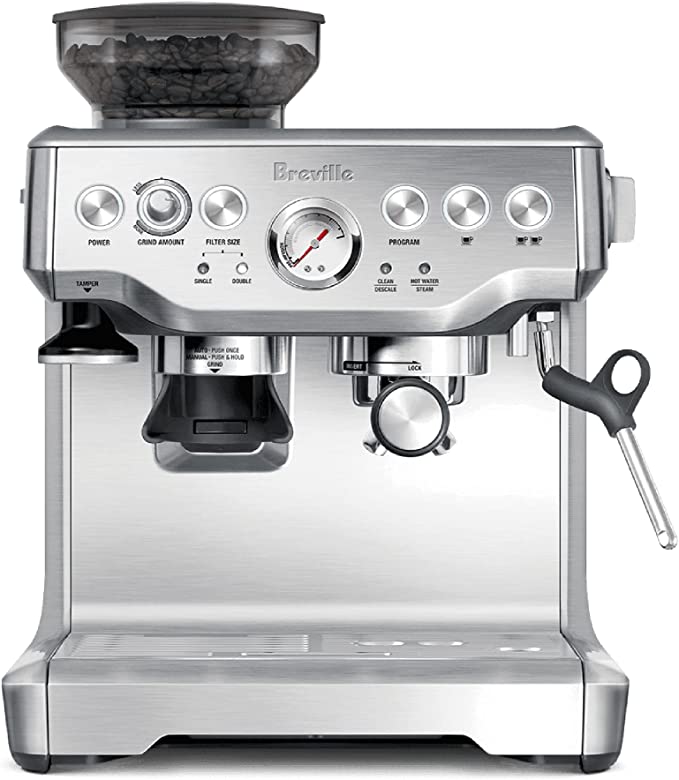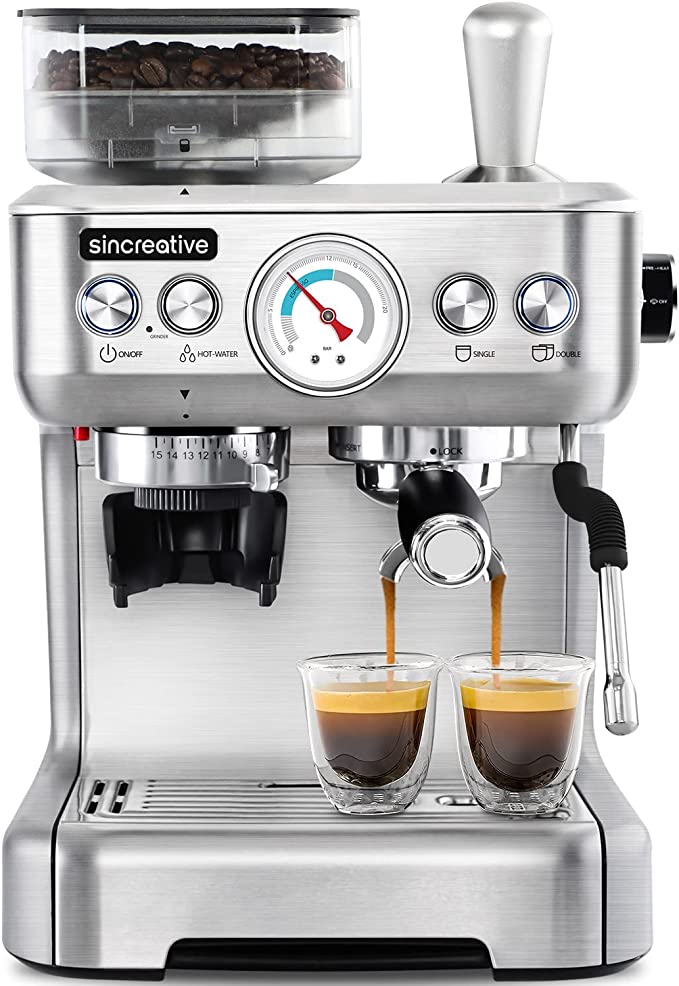Breville BES920XL: Mastering Espresso Extraction with Fluid Dynamics
Update on Sept. 16, 2025, 11:59 a.m.
It’s not magic, it’s a beautifully controlled dance of thermodynamics and fluid dynamics. Let’s break down the science behind the perfect shot.
There’s a quiet moment, just as the day begins, that holds a universe of complexity. It’s the moment a stream of viscous, hazel-colored liquid, crowned with a fine, persistent crema, flows into a pre-heated cup. The air fills with an aroma of chocolate, nuts, and fruit. This is the promise of a perfect espresso shot—a fleeting, multi-sensory experience that can elevate a morning from mundane to magnificent.
For decades, achieving this moment consistently at home felt like a dark art, a secret language spoken only by seasoned baristas. We’d follow the rituals, buy the freshest beans, and yet, the result was often a lottery—one day sublime, the next a shadow of its potential. Why?
The answer has little to do with magic and everything to do with physics. An espresso machine is not merely a coffee brewer; it is a sophisticated process-control system designed to wage a constant, calculated war against a hostile physical world. The quest for the perfect shot is a story of taming pressure, defying thermodynamics, and mastering the chaotic flow of water through a tightly packed medium.

The Brute Force of Elegance: Mastering Pressure
At its core, making espresso is a violent act. We are forcing water, heated to near boiling, through a densely compacted puck of finely ground coffee. This puck is a porous medium, a miniature labyrinth of particles offering immense resistance. To overcome this, we need force. This is the realm of fluid dynamics.
The story of modern espresso begins in 1947 with Achille Gaggia. He abandoned the low-pressure steam methods of his time and introduced a spring-loaded piston, capable of generating around 9 bars of pressure—nine times the Earth’s atmospheric pressure at sea level. This was the breakthrough. This intense pressure was found to be the sweet spot, powerful enough to emulsify the coffee’s natural oils into a stable foam—the crema we now consider the hallmark of a great espresso—without being so destructive that it pulverizes the grounds and extracts an excess of bitter compounds. The 9-bar standard was born.
The challenge, however, is that raw power is clumsy. Many consumer machines today advertise powerful 15-bar or even 19-bar pumps. But applying that much force directly to the coffee would be like trying to water a delicate flower with a firehose. It would blast channels through the puck, causing water to bypass most of the coffee and leading to a shot that is simultaneously sour (under-extracted) and bitter (from the over-extracted channels).
This is where elegant engineering intervenes. A well-designed modern machine uses an Over-Pressure Valve (OPV). It’s a beautifully simple concept: the powerful pump provides more than enough force, and the OPV acts as a gatekeeper, bleeding off any pressure that exceeds the ideal 9 bars. It tames the brute force, ensuring the water greets the coffee with a firm, consistent, and unwavering handshake, not a punch. This single component is a critical first step in transforming a chaotic process into a repeatable one.

The Relentless Pursuit of Stability: A War Against Thermodynamics
If pressure is the force, temperature is the catalyst. It dictates which flavor compounds are dissolved from the coffee grounds and at what rate. The ideal window is incredibly narrow, generally accepted to be between 195-205°F (90-96°C). A degree or two too low, and you get a sour, acidic shot. A few degrees too high, and you scorch the grounds, resulting in bitter, ashy flavors.
Here, we enter a battle with one of the most fundamental laws of the universe: the Second Law of Thermodynamics. Heat naturally moves from hotter objects to colder ones. Entropy, or disorder, always increases. Your espresso machine is a system constantly trying to lose heat to the colder air, the cold countertop, and its own cooler components. Maintaining that tiny temperature window is a heroic act of defiance.
Engineers fight this war on three fronts. The first is the heart of the system: the boiler design. The gold standard in high-end machines is a dual boiler system. A machine like the Breville Dual Boiler dedicates one stainless steel boiler exclusively to heating water for the espresso to a precise ~200°F, and a separate, second boiler to creating much hotter steam for frothing milk. This isolation is crucial. It prevents the temperature drop that occurs in lesser machines when they have to switch from brewing to steaming, ensuring the brew water remains unshakably stable.
The second front is the brain: the PID controller. A PID (Proportional-Integral-Derivative) controller is a world away from a simple thermostat. A thermostat is a blunt instrument; it turns the heater on full blast until it overshoots the target, then turns it off completely until the temperature drops too low. It’s like driving a car by flooring the gas and then slamming on the brakes. A PID, in contrast, is like an expert chauffeur with cruise control. It’s a smart algorithm, born from industrial process control, that constantly monitors the temperature. As it approaches the target, it intelligently eases off the power, feathering the heat to land precisely on the setpoint and hold it there with minimal fluctuation, often within a single degree.
The final front is the last mile: the group head, where the portafilter locks in. This large piece of metal is a major potential heat sink. Some of the most legendary commercial machines, like those from La Marzocco, solve this with saturated group heads, making them a literal extension of the boiler. A more accessible, yet highly effective solution found in advanced consumer machines is an actively heated group head. An embedded heating element ensures that this final point of contact is at the same temperature as the water, preventing a final, fatal temperature drop just before extraction. It’s the culmination of a relentless, system-wide battle to deliver water to the coffee in its most perfect, stable state.

The Gentle Persuasion: Flow, Chemistry, and the Avoidance of Chaos
Having mastered pressure and temperature, we face one final challenge: ensuring the water flows evenly through the entire bed of coffee. This is where the dreaded “channeling” can ruin a perfectly prepared shot.
The physics is one of uniform saturation; the chemistry is one of sequential extraction. When water first hits the coffee, the most soluble compounds—fruity and bright acids—dissolve first. These are followed by sugars, which provide sweetness and body. Finally, the least soluble compounds, the melanoidins and other complex carbohydrates responsible for bitterness and texture, are extracted.
If water flows too quickly through one part of the puck (a channel), that part will be over-extracted and bitter, while the rest of the puck is under-extracted and sour. The resulting cup is a discordant mess.
The engineering solution is as elegant as it is crucial: low-pressure pre-infusion. Before unleashing the full 9 bars, the machine first introduces a gentle stream of water at a fraction of that pressure. This allows the coffee grounds to swell, release trapped CO2 gas from the roasting process, and settle into a more homogenous, stable structure. It’s like allowing a sponge to fully absorb water before squeezing it. This “blooming” of the puck heals any tiny cracks or inconsistencies from tamping, creating a uniform medium that can withstand the later onslaught of high pressure. It gently persuades the coffee to give up its flavors evenly and harmoniously.
From Art to Science, and Back Again
Pressure, temperature, and flow—this is the holy trinity of espresso, each governed by fundamental laws of physics. A machine that masters them is not a magic box. It is a finely tuned instrument. It doesn’t replace the skill of the user—the choice of bean, the freshness of the roast, the precision of the grind, the evenness of the tamp—but it provides a reliable, repeatable canvas on which that skill can be expressed.
It transforms the process from a guessing game into a science. When a shot tastes sour, you now know to suspect an issue with temperature or flow, not to blame fickle coffee gods. The value of a sophisticated machine is that it removes the variables, giving you the control to experiment, to learn, and to create.
The next time you stand before your machine, listen to the hum of the pump and watch that perfect stream of liquid form. You’re not just making a beverage. You’re witnessing the elegant application of a century of science and engineering, all focused on creating one perfect, fleeting moment in a cup. You’re tasting physics. And it is delicious.







































